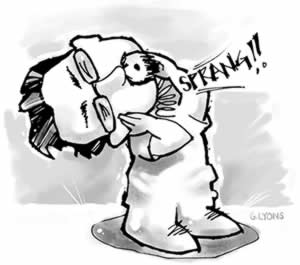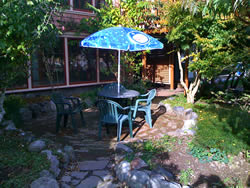
Stretching Injury
How I almost ripped my own head off! A cautionary tale about the risks of injury while stretching
I am my own laboratory. And, sometimes, things in labs blow up.
I mostly avoid telling stories about self-treatment tactics that worked for me, even though I know that they are emotionally compelling and I could probably use them to sell more books. Tempting! When my own efforts go wrong, however, there is a great opportunity for a credible, ethical, teachable moment about stretching and neck pain.
So I’d like to tell you about the time I almost ripped my own head off.
This is one of the worst self-treatment disasters I’ve ever been through. In fact, I can’t actually recall ever doing myself so much harm.
The problem: a crick in the neck
I’d had a crick in the neck for about a day, and it was getting slowly but steadily worse. I was on Bowen Island, just offshore from Vancouver, staying in the lovely Garden Suite at the Union Steamship Company Marina for a weekend writing retreat.
A crick in the neck is a tricky phenomenon to explain. It is not just neck pain — it’s neck pain and/or a nagging feeling of stuckness or mechanical disruption in the spine. It may or may not involve any such thing, but that is certainly what it feels like. There are probably different kinds of cricks, with different causes. They may last for a few minutes or a few years.
And you certainly don’t want one getting worse as you head into what is supposed to be a pleasant working holiday.

Scene of the crime.
This is my little home away from home on Bowen Island where I go to write. And stretch.
The treatment: a hot soak and a stretch
The Garden Suite has a marvellous big old tub which I like to soak in between writing sessions and little hikes. I’d just finished a nice hot soak that hadn’t really put a dent in the crick, so I decided to try “a little stretching” in addition to the heat of the bath.
Actually, I decided to try “a lot of stretching.” I decided I was going to stretch it hard. I had three reasons:
- It had worked before. Back in 2007, I’d had a particularly good result from a hard stretch of a very similar neck crick. That was a success story, and a good one. This crick felt the same. Perhaps the same treatment would work again! Hope springs eternal. (So does stupidity.)
- I was really relaxed and toasty warm from the bath.
- I like to experiment.
So I started stretching! The crick was deep in the lower right cervical spine, in the corner between the shoulder and the neck — what I call the “sheck.” Tilting my head to the left, I could feel a distinct, triggery line of aching tension through the sheck that felt like scratching a deep itch. Not only did it feel good, but the sensitivity eased steadily as I held the stretch at a moderate intensity. It seemed like I was being rewarded for my slow, methodical stretch.
I gave myself plenty of time to adapt to a moderate intensity. I kept releasing the stretch slowly and re-applying it, testing the waters, until the movement felt smooth and unrestricted. It seemed to be going well, and it felt great, so I upped the ante and started to stretch hard, and then really hard. This was a truly strong stretch.
It was that “scratching the itch” feeling that kept me going. It felt like good massage. It felt satisfying. There was not a trace of evil in it. Which is quite interesting — interesting that I was so clueless — considering how this turns out. Something bad was happening but it felt good.
I stretched hard and long. I basically stretched as hard as I could, limited only by my range of motion and patience. I slowly sank back into the bath to recover from this most epic of stretches, sighing deeply.
First impressions aren’t everything
Victory seemed certain. I felt great in the minutes after the stretch. My range of motion was full and free and painless. I could no longer detect that distinctive cricky sensation in my sheck. “O frabjous day! Callooh! Callay!” He chortled in his joy.
I cockily proceeded with my day, thinking about how I might write the experience up as a stretching success story — two good victories over neck cricks might just be worthy of a good anecdote.
Not so fast, buddy.
About twenty minutes later, I noticed an evil little ache blossoming in the same spot. It was coming on fast. Within another half hour, the crick was back, and I was shrugging it off as a mere failure to treat. But it kept getting worse. And worse. And worse …
The results: mostly disastrous
Over the next three hours, my annoying little neck crick turned into a full-blown three-alarm fire. It was not much different in quality than before — more burning, but otherwise basically the same sensation. But it grew to be so much more intense that it defied quantification. Six times worse? Nine? Does it matter?
It was bad.
I had clearly either injured myself, severely aggravated the problem, or both. I cannot overstate how miserable I got. For the next three days — long days of computer time — I suffered the equivalent of a pounding headache in my neck, a hot grinding ache that had me squirming and grabbing at my neck constantly. This terrible thing I had done to myself resisted everything else in my self-treatment toolkit. Which is large, of course — I do publish the world’s largest and oldest website about self-help for aches and pains, after all! Fat lot of good it did me. I was not able to put a dent in the pain.
After a couple of days, I pretty much gave up trying. It seemed increasingly clear that only time and rest were going to help. I did my best to calm down and minimize irritation, especially postural stress. But it was an ugly situation. By day three, it was difficult to hold my head up for more than five minutes, and even five minutes at the computer would whip it into a frenzy.
The first signs of relief finally came on day four, after a good sleep in my own bed. It slowly calmed down over the next five days until I had one of those “hey, I haven’t noticed that pain in a while” moments.
I feel lucky that it calmed down as quickly as it did.
Was it worth the risk?
No.
My hard stretch might have worked, after all, the way it did in 2007. I have no idea what the difference is. But no — it wasn’t worth it, and I will never take a chance with a hard stretch like that again. I would far rather sacrifice the chance of a quick cure than risk ever giving myself a week like that.
Don’t assume that stretching must be good for you just because it feels good. In fact, you can’t even assume that it’s safe.
Recommendations
Do what I should have done: start with a gentler stretch. Up the ante only if that goes well. Yes, a more cautious approach may mean that you give up the slim hope that more would have been better … but you also avoid the kind of disastrous backfire that I had.
I don’t want this story to scare people away from stretch. But I do want it to plant a seed of caution. It is a tool to experiment with, but avoid extremes and “believing” in stretching and promoting and recommending it as if it were nothing but pure goodness — and that goes double for health professionals. The only thing that seems to be certain about stretch is that nothing is certain.
About Paul Ingraham

I am a science writer in Vancouver, Canada. I was a Registered Massage Therapist for a decade and the assistant editor of ScienceBasedMedicine.org for several years. I’ve had many injuries as a runner and ultimate player, and I’ve been a chronic pain patient myself since 2015. Full bio. See you on Facebook or Twitter., or subscribe:
Related Reading
- The Unstretchables — Eleven muscles you can’t actually stretch hard (but wish you could)
- A Stretching Experiment — What happens when you stretch your hamstrings intensely for several minutes a day in a steam room?
- The Complete Guide to Trigger Points & Myofascial Pain — An extremely detailed guide to the unfinished science of muscle pain, with reviews of every theory and treatment option